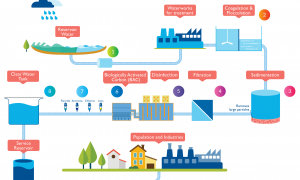🕑 Reading time: 1 minute
A groyne is a rigid hydraulic structure built either from the shore (in case of seas) or bank (in case of rivers) in order to dissipate the wave energy or to protect the banks from erosion by
In general, Groynes are perpendicular to the
Contents:
Classification of Groynes
Groynes are classified into different types based on different factors which are as follows :
- Materials used for construction
- Permeability characteristics
- Height of groynes
- Function of groynes
Types of Groynes based on Materials Used for Construction
Based on the materials used in construction, the groynes are classified into :
- Wood groynes
- Sandbag groynes
- Rock groynes
- Concrete groynes
- Sheet pile groynes
- Rubble-mound groynes
1. Wood groynes
Wooden groynes are built with timber piles. Generally, single row or double row wooden groynes are constructed as they suffice the requirement. The durability of wooden groynes is very low but they are economical and useful for short term purposes.

2. Sandbag Groynes
Sandbag groynes are constructed using sand or earth-filled bags which are stacked in the form of barrier. They are used for temporary or short-term purposes. To prevent the sinking of sandbags into the ground, a special type of filter cloth is provided under the bags.

3. Rock Groynes
Rock groynes, constructed using large sized rocks have more durability compared to other materials. They absorb a good amount of wave energy and maintain a good stability in any situation.

4. Concrete Groynes
Concrete groynes are constructed using reinforced concrete or pre-fabricated concrete blocks. These are the most stable and durable structures. Good foundation and appropriate soil conditions are required to construct concrete groynes.

5. Sheet pile Groynes
Sheet pile groynes are constructed using steel sheet piles. The sheets pile groynes constructed are either single sheet pile or double sheet pile. However,

6. Rubble-mound Groynes
Rubble-mound groynes are widely used structures along the seashores. They are built using stones or specially made concrete units such as tetrapods. To attain more strength, sheet piling is provided inside the rubble-mound groynes. Durability and stability of rubble-mound groynes are very high.

Types of Groynes based on Permeability Characteristics
- Permeable groynes
- Impermeable groynes
1. Permeable groynes
Permeable groynes permit water through it but with a reduced velocity of flow. Groynes built using wood, sandbags etc. come under this category. This type of groyne is suitable when a river is carrying a
2. Impermeable groynes
Impermeable groynes do not permit water to flow through them. They are made of rock,
Types of Groynes based on Height
- Submerged groynes
- Non-submerged groynes
1. Submerged groynes
Submerged groynes are constructed where river depth is very deep. Their submergence condition varies according to the water surface level in the river. Permeable materials are used to construct this type of groynes and they reduce flow velocity that results in preventing erosion of the top portion of the groyne.

2. Non-submerged groynes
Non-submerged groynes are constructed with a

Types of Groynes based on functions
- Attracting groynes
- Repelling groynes
- Deflecting groynes
- Sediment groynes
1. Attracting groynes
Attracting groynes are constructed in such a way that their head is pointing towards the downstream side of the river as shown in the figure below. They are built with an angle of 45 to 60 degrees with the bank. Since it is inclined towards downstream, the water-flow will attract towards the bank on which groyne is located.

2. Repelling groynes
Repelling groynes are built with their head towards upstream with an inclination of 60 to 80 degrees with the bank. They repel the water-flow towards the bank on which it is located.

The head portion of repelling groynes is under the
3. Deflecting groynes
Deflecting groynes are built perpendicular to the bank and they just deflect the water-flow without repelling and provide local protection to the banks.

4. Sediment groynes
Sediment groynes are constructed when there is a considerable amount of sediments carried by the river water. These reduce the stream velocity and allow the sediments to deposit. They do not repel or deflect the flow. Generally, permeable groynes are used as sediment groynes.



